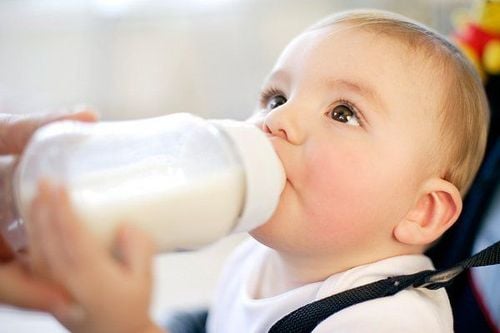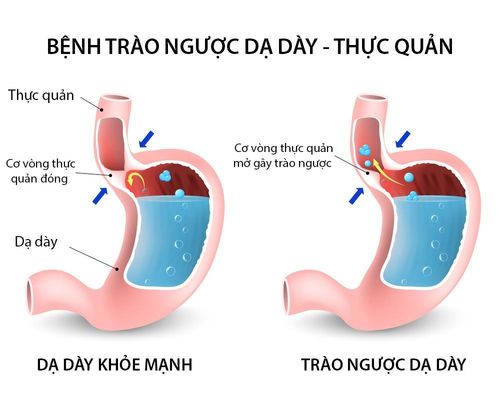This is an automatically translated article.
This article is professionally consulted by Master, Doctor Vu Quoc Anh - Pediatrician - Pediatrics - Neonatology Department - Vinmec Danang International General Hospital.Choking milk is a very common accident in young children that confuses many mothers, especially those who have just given birth for the first time. In order to breastfeed in the right position, with the right latch, and how to effectively handle choking, many young mothers are very concerned.
1. Baby choking on milk
Choking milk (vomiting) is a phenomenon where milk spills into the respiratory tract, making it difficult for children to breathe, choking, cyan, and can cause respiratory arrest. When choking, the baby has a reflex to inhale air to cry loudly, causing the milk to be pushed deeper into the trachea and bronchi, causing suffocation. This phenomenon occurs commonly in newborns to less than 1 year old and needs to be treated quickly to avoid life-threatening. In addition to choking on milk, babies can also choke on water, choke on food, choke on reflux, or choke on gastric juices.
Parents can recognize that their child is choking on milk through the following signs:
The child is nursing (or after feeding) suddenly coughing, coughing, cyanosis, crying Milk comes out of the nose, mouth of the child, the child is sick. panic, body flaccid or stiff In severe cases, the child can have cardiac arrest, stop breathing or even die if not given first aid in time.
Trắc nghiệm: Thế nào là trẻ sơ sinh đủ tháng?
Đặc điểm bên ngoài của trẻ sơ sinh đủ tháng được thể hiện qua các tiêu chuẩn như: Cân nặng, chiều dài và hình thể. Theo dõi bài trắc nghiệm dưới đây sẽ giúp các bậc cha mẹ hiểu thế nào là trẻ sơ sinh đủ tháng, qua đó có thể đánh giá tổng trạng sức khỏe và sự phát triển của bé yêu nhà mình.The following content is prepared under supervision of Thạc sĩ, Bác sĩ y khoa, Ma Văn Thấm , Nhi , Phòng khám Đa khoa Quốc tế Vinmec Dương Đông(Phú Quốc)
2. Causes of choking milk in young children
Newborns choking on milk is a common phenomenon, but the cause of choking is mostly because parents are breastfeeding in the wrong position. Some of the wrong eating positions that make it easy for babies to choke on milk are:
Breastfeeding lying down or putting a bottle on a pillow for the baby to feed on their own Many mothers have the habit of feeding their baby lying down and sleeping while eating. However, during feeding, it is likely that the baby will oversleep, with the nipple in his mouth but not swallowing. When breathing heavily, the baby accidentally inhales milk up the nose into the bronchi, leading to choking of milk and difficulty breathing.
Lie down to drink water, tilt your head to drink water when your baby hiccups
Similar to the above, feeding the baby while lying down or tilting his head when drinking water can also cause water to rush straight into the bronchi, causing choking for the child.
After the baby is full, let the baby sleep with the head up. Babies who are nursing or after feeding often fall asleep. Many mothers see this often put the baby to sleep fixed in the head-up position. This is very dangerous because the baby has just eaten, so the possibility of choking on milk is very high, adding that the inability to turn the baby's head makes it impossible for the baby to get rid of the choking, breathing difficulty.
Feed and suck the baby when the baby is in an emotional state Around 4 months old, babies tend to know how to talk, easily react to the mother's actions. If the mother breastfeeds the baby while the baby is showing emotional expressions such as laughing, crying, or coughing, it is easy for the milk to overflow into the baby's windpipe and cause choking.

3. Anti-choking skills in babies
Choose the right time to breastfeed In order to prevent the baby from choking on milk, parents should choose the right time to breastfeed, not always feed the baby. For example, when a child is crying, laughing or coughing, parents should not try to force the child to eat because at that time, the child is easy to choke.
In addition, you should also avoid breastfeeding when too hungry, when the baby is empty, they often suckle quickly without having time to swallow milk. On the contrary, when the baby is full, you should not try to force it because it can cause problems: vomiting, spitting up...
Choosing the right eating position for the baby Parents should avoid letting the baby suck at the same time. sleep, this helps children form the habit of eating right, scientific meals, and prevent vomiting, choking milk. Breastfeeding positions also need to be noticed by mothers. The baby's neck should not be tilted or bent when eating, instead, the mother should hold the baby to sit when feeding, eating or drinking water.
When holding a bottle to breastfeed, mothers should tilt the bottle about 45 degrees so that the milk flows evenly down the nipple, so that the baby will not have to suck much, causing air to cause bloating and gas.
In any position, parents should try to keep the bottle stable, do not change too many positions to avoid shaking the bottle, creating air bubbles in the milk.
Adjusting the baby's sucking speed For premature or premature babies, mothers should patiently feed the baby slowly and observe the baby's expression. If you see your baby coughing or crying, stop immediately. For bottle-fed babies, choose a bottle with a normal nipple hole, not too big, this helps milk flow gently to help prevent choking in babies.
Notes after breastfeeding After finishing feeding, need to hold the baby in an upright position, with the body pressed against the mother's breast, the baby's face on the mother's shoulder, and then gently pat the baby's back to burp for a while. After that, the mother gently put the baby to lie down on the left side, with a slightly high pillow.
After the baby is finished feeding, do not put the baby down immediately, do not play with it, lift it up and down. In case of force majeure, the mother can also let the baby lie down immediately after feeding, but it is necessary to place the baby's head 15 degrees higher than the bed surface (the baby's head is higher than the body). At the same time, adjust the baby's face to one side for about 30 minutes, then let it lie on its back as usual.

4. How to handle when your baby chokes on milk
If the baby shows signs of choking, mothers should perform basic first aid operations for the child immediately.
Mouth and nose suction Step 1: It is necessary to quickly remove the milk that is in the child's throat and nose by sucking strongly into the child's mouth and nose. Suction mouth first, nose behind. The faster you pump, the better because if it's slow, it will cause the milk to go deep into the trachea, causing airway obstruction.
Step 2: The longer the baby is blocked, the more difficult it is to save, so after pumping, the mother should stimulate strongly so that the baby can cry and breathe. After that, the mother quickly took the child to the nearest hospital for first aid.
Back patting, chest compressions Step 1: If the child shows signs of cyanosis, difficulty breathing: parents, please put the child lying face down on the palm and right arm, in the position between the shoulder blades, and pat 5 times firmly. the child's back and then turn the child over. The goal is to increase the pressure in the chest to expel the milk from the baby's airway. If the child can cry, the body is not pale, then quickly move to the nearest hospital or facility for further monitoring.
Step 2: If the child is still having difficulty breathing and is pale, then the mother puts the child on his or her back on a hard surface, using the middle and index fingers to press 6 times continuously under the breastbone and the seam connecting the two sides of the chest until the baby signs of recovery.
For children with symptoms of apnea, the above measures can be combined with rescue breaths. First-aiders should quickly close the child's nose and mouth and breathe in until the baby's chest rises slightly. Then the family must immediately take the child to the nearest hospital for timely emergency medical attention.
With many years of experience in examining and treating diseases in children, now the Pediatrics Department at Vinmec International General Hospital has become one of the major health care centers, capable of examining , screening and treatment of many specialized diseases in children. Therefore, if the child shows signs of poor absorption of nutrients, slow weight gain, growth retardation, etc., parents can take the child to Vinmec International General Hospital for examination and support. advice from qualified doctors.
Please dial HOTLINE for more information or register for an appointment HERE. Download MyVinmec app to make appointments faster and to manage your bookings easily.















